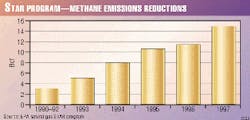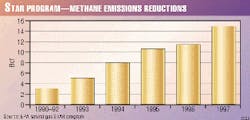US firms press greenhouse gas initiatives
Eventually researchers may reach a consensus as to whether catastrophic global warming is a reality, but until they do, US oil and natural gas companies are taking matters into their own hands.
During the American Petroleum Institute's 2-day conference on the oil industry's climate change initiatives last month, more than 2 dozen climate-change specialists from the industry and academia discussed techniques currently used in the industry to reduce greenhouse gas emissions, as well as new technologies for the future.
Companies are reducing emissions in response to regulations, as well as through voluntary government programs such as the US Environmental Protection Agency's Energy STAR Buildings partnership, formerly known as the Green Lights partnership, and the Natural Gas STAR program.
Looking at technologies for the future, conference speakers focused on carbon sequestration and vehicular applications.
Energy STAR Buildings
The EPA Energy STAR Buildings partnership is a voluntary partnership between US organizations and EPA to promote energy efficiency in commercial and industrial buildings. The primary focus of the program is to help companies better manage their buildings' energy costs and use. In addition to concerns over related air emissions, wasted energy is also a huge economic loss for many companies. By 2010, energy waste will have cost the owners of these buildings about $130 billion, said Natural Gas STAR program manager Paul Gunning.
A central component of the Energy STAR Building partnership is a five-stage energy upgrade strategy, which reduces equipment costs and enables building owners to achieve energy savings while lowering capital expenditures.
The five-stage upgrade program includes: 1.) "green" lights, 2.) building tune-up, 3.) HVAC load reductions, 4.) fan systems upgrade, and 5.) HVAC (heating, ventilation, and air conditioning) plant improvements.
The five stages of the program are sequenced to maximize savings, prevent oversizing, and minimize equipment costs. Partners are expected to follow these staged implementation strategies in upgrades only where economic.
Mobil Corp. (now part of ExxonMobil Corp.) joined the Energy STAR Buildings partnership in 1995 and has currently saved $103 million/year just by implementing the resources offered by the partnership.
Over 3,000 organizations have joined the Energy STAR Buildings-Green Lights partnership, saving over a combined $1.4 billion in energy costs. As a result of their energy-efficiency upgrades, they have also prevented 44.1 billion lb of carbon dioxide from being released into the atmosphere, which is equivalent to removing 1.6 million vehicles from the road, said Gunning.
Natural Gas STAR
The Natural Gas STAR program is another voluntary government program, which works directly with the natural gas industry to find cost-effective ways of reducing methane emissions. The program consists of three initiatives focused on the transmission and distribution sectors, the production sector, and the gathering-processing sector.
Since the program was launched in 1993, production, transmission, and distribution partners have reduced methane emissions by 75.8 bcf through the implementation of cost-effective best management practices (BMPs), which are technologies and practices that companies can implement to reduce leaks and losses of natural gas (see chart). The STAR program offers two core BMPs for production companies and five for transmission and distribution companies. It also offers more than 50 partner-reported opportunities (PROs), which are technologies and practices reported by Natural Gas STAR partners as "other BMPs."
The STAR Program production partners have reduced costs and increased revenues while preventing gas losses in excess of 35.4 bcf by implementing PROs and two core BMPs. Examples include replacing high-bleed pneumatic devices and installing flash-tank separators on glycol dehydrators.
Mobil Exploration & Producing U.S. Inc. has been a participant in the Natural Gas STAR producer program since 1995. The firm reported about 946 MMcf in reductions in 1997, bringing Mobil E&P's cumulative reported methane emission reductions during 1990-97 to 2.5 bcf. With methane emissions reductions reported in 1998, Mobil E&P's cumulative total rose to 3 bcf.
By 2000, Natural Gas STAR partners will reduce methane emissions by more than 44 bcf/year, which is the carbon equivalent of removing 2.6 million cars from US highways.
Future technologies
The US Department of Energy is developing a collaborative research and development program on carbon sequestration, a technique used for managing carbon emissions.
The report covers five potential techniques for long-term carbon sequestration: separation and capture of CO2 from energy systems and sequestering it in geologic formations, oceans, and terrestrial ecosystems; and chemically or biologically converting CO2 into commercial products. Within the industry, numerous field tests are being conducted on CO2 injection for improving oil recovery and carbon sequestration in saline formations.
At Saskatchewan's Weyburn oil field, CO2 enhanced recovery is being used to substantially increase the projected life of the reservoir, which is currently in production decline, having produced in excess of 80% of the estimated reserves, said Ray Hattenbach, general sales manager of Dakota Gasification Co. (DGC). Weyburn field has produced about 327 million bbl of oil from primary and waterflood efforts. Starting in the fall of 2000, PanCanadian Resources Ltd. will inject about 95 MMcfd of CO2 into the Weyburn reservoir to produce an estimated 138 million bbl of incremental oil. The CO2 will be transported in a dense phase by a 330-km pipeline from the Great Plains synfuel plant in Beulah, ND, which currently vents the CO2 to the atmosphere, to Weyburn field. DGC operates the coal-based, commercial-scale synfuel plant. PanCanadian anticipates production at Weyburn will exceed 30,000 b/d by 2008 compared with its estimate of only 10,000 b/d without the CO2. By the end of the projected 25-year life of the project, PanCanadian will have invested $1 billion (Can.), said Hattenbach.
In another project, Norwegian state oil company Statoil has started field-testing the sequestering of CO2 in deep saline formations to determine the long-term impact on the environment. Statoil is injecting about 1 million tonnes/year of recovered CO2 into the Utsira sand, a subsea saline formation associated with Sleipner giant oil and gas field's West Heimdal gas reservoir. The amount being sequestered is equivalent to the output of a 150-Mw coal-fired power plant. It is the only commercial CO2 geological sequestration facility in the world, according to DOE's R&D report.
One of the primary objectives of the R&D program is to lower the cost of reducing carbon emissions. Currently, CO2 sequestration costs are $100-300/ton of carbon emissions avoided. The program goal is to reduce the cost by a net $10/ton or more by 2015. The program's budget request for fiscal 2000 is $9 million and is projected to increase to $24 million in fiscal 2001.
DOE claims the benefits of improved sequestration technology in meeting greenhouse gas emissions reduction targets could result in a cumulative savings to the US economy of $2.7 trillion by 2050.
Vehicles of the future
Because automobiles account for the lion's share of carbon emissions, industry is placing a significant emphasis on new automotive technologies.
"The emerging fuel cell technology for automotive applications holds the promise for significant fuel economy improvements and minimal regulated emissions vs. today's internal combustion engines," said Charles Darnell, senior staff planning analyst at ExxonMobil Corp. "As such, automakers have expanded their efforts to develop this technology for the future generation of vehicles."To further advance automotive fuel-cell technology, petroleum companies have established various partnerships and organizations with the automotive industry, such as the Partnership for a New Generation of Vehicles and the California Fuel Cell Partnership (CFCP). The CFCP will place about 50 fuel-cell passenger cars and buses on the road during 2000-03.
"Looking to the future, the oil and natural gas industry's agenda will include continued sharing of information on voluntary actions, additional climate-related research, reporting progress in controlling greenhouse gas emissions, and pursuing partnerships with government and others in the private sector to further manage emissions," said API Pres. Red Cavaney. "In fact, intensive use of technology is making the 100-year-old-plus petroleum industry an innovative, visionary, and highly efficient 'new' industry."

